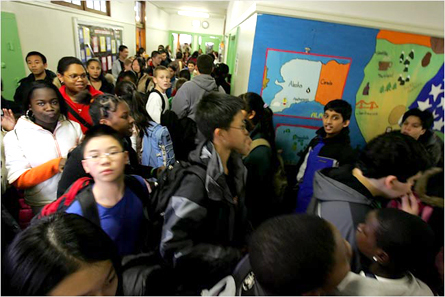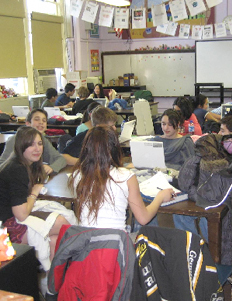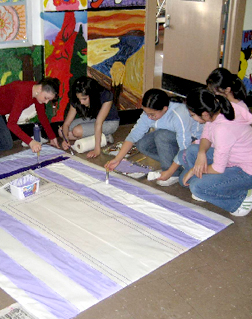
Photo: Ruby Washington/The New York Times
On most mornings about 1,000 students show up at I.S 287, the Christa McAuliffe School in Bensonhurst Brooklyn. Whatever gripes they have about having to go to school and whatever adolescent angst preoccupies them at the moment, they are by most accounts lucky to be there. "The teachers are great, and even though there is overcrowding in such a small school, … you still get individual attention," one student told Inside Schools. “Not only have I learned so much, but I made great friends at Christa McAuliffe," another wrote.
McAuliffe is one of New York City’s approximately 600 middle school programs, and by many measures, it ranks near the top. To get in students must score well on standardized fourth grade tests, with priority given to those who live in the area.
But Christa McAuliffe and other highly regarded public middle schools in the city are seen as the exception rather than the rule. Thousands of the city’s approximately 200,000 sixth, seventh and eighth graders attend school that the state department of education cites as failing. Many feel unsafe in their classrooms and hallways. And more than half spend their days in schools where most of their fellow students cannot read or do math at their grade level.
Some hailed test scores released last month as an indication that New York has begun to solve its middle school problem. Almost 49 percent of city eight graders met state standards on the reading test, up from 36.6 percent last year. But the middle school scores still represent a dramatic falloff from elementary school: 56 percent of fifth graders met the standards.
The years between elementary school and the start of high school are generally viewed as education’s problem stage. While education from pre-K to post graduate poses challenges, the age of the students, the structure of the system and the training for teachers make the middle school level particularly daunting. Why is middle school education such a quandary? And what can New York City do about it?
MIDDLE YEAR SLUMP
After years of neglect, middle schools have begun to attract increased attention from educators, politicians and journalists. Throughout the country, "this is a time of middle school experimentation," education reporter Jay Matthews wrote in the Washington Post.
In New York City, the new school budgets released in May increased funding for middle schools. The Department of Education has enlisted the Academy for Educational Development, an independent nonprofit to help failing middle schools in the city and is looking for other ways to improve education at this level. Citing poor test results, the City Council has created a task force on middle school reform chaired by New York University education professor Pedro Noguera.
Why are policy makers turning their attention to middle schools?
It is partly a result of No Child Left Behind. Under that federal law, middle school students must take standardized tests and meet state proficiency standards. The tests bolstered what many educators suspected all along -- that middle schools tend to be the weak link in U.S. education.
Last year’s poor test results for New York State eighth graders spurred schools to act, according to state education commissioner Richard Mills. “Last year was a dramatic moment,'' Mills told the Times recently. ''I think that was a very sobering picture for people.”
Then too, the middle school problem may have become too big to ignore. Many educators believe the ills facing urban high schools, particularly high truancy and dropout rates, have their roots in middle school.

The middle school years “are marked by a precipitous decline in test scores … which directly affects high school acceptance and drop out rates,” wrote Evelyn Castro, associate dean of the School of Education at Long Island University’s Brooklyn campus.
The city’s middle schools are “failing our children dramatically,” Carol Boyd of the Coalition for Educational Justice told a reporter earlier this year. “By the time they reach high school, they are so far behind that they’re so frustrated, they have no alternative but to drop out.”
Of the nine schools added in January to the state's list of badly failing schools, eight were middle schools.
Even with the jump in test scores, most eighth graders do not meet state standards for reading. And the problem is worse at schools with large number of black and Latino students. An analysis of the 2006 test scores, done by the Annenberg Institute for School Reform for the Coalition for Educational Justice, found high performing school were less than half black and Latino, while low performing schools had student bodies that were virtually 100 percent black and Latino.
Various experts question the validity of the tests. Jill Herman, a former middle school principal now with the Urban Academy, a private group that creates public schools in New York, questions whether in some years the eighth grade test has been too difficult, creating low scores that have fueled “alarmist” talk about middle schools. Others wonder whether the 2006 test was easier than previous exams, accounting for the rise in score.
But numbers aside, most experts concur that middle schools have a long way to go, as Schools Chancellor Joel Klein has acknowledged. Discussing overall test results for the city, he said, "It's a question of whether the glass is half empty or half full." In his opinion, "it's clearly half full.” But Klein does not seem to have a sweeping vision for middle schools. In an interview with Gabe Pressman on WNBC earlier this year, Klein said, “The big crisis in middle school is we’ve got to get more high quality teachers.” He offered few specifics about how he hoped to accomplish that.
HISTORY LESSON
Klein is hardly the first educator to face the middle school conundrum. Students used to stay in one school from first through eighth grade, when many ended their formal educations. But that began to change early in the 20th century, as the first junior high schools in the country opened in 1909. By the 1930s, New York City saw a sharp increase in the number of these schools “in part to relieve high school congestion but also to provide a place for vast numbers of overage elementary school children,” Diane Ravitch writes in The Great School Wars.
In the 1950s, so-called middle schools began replacing junior high schools. The distinction remains obscure to many parents and teachers, but according to Ron Banks of the Clearinghouse on Early Education and Parenting, “The middle school movement builds on the junior high school core curriculum,” but also sought to address the adolescents’ emotional needs.
New York City’s middle school program includes schools dubbed I.S. (intermediate school), M.S. (middle school) or J.H.S (junior high school). Such designations seem more a matter of tradition and convenience than anything else.
Whatever it called the schools involved, New York City has tackled middle school reform before. In the 1970s and 1980s, District 4 in East Harlem, in an effort to fight poor academic performance, eliminated neighborhood middle schools and started a number of alternative schools to which students had to apply. Other districts, notably District 2 in Manhattan, copied that approach. The schools there remain among the most sought after in New York. But specialized schools, although copied by other districts, provide no guarantee of success.
While Mayor Michael Bloomberg and Klein have made major changes to the school system, at least until recently, they did not focus much on middle schools. The report on city middle schools by the Coalition for Educational Justice charged that the administration has continued “the pattern of neglect,” saying, “The administration has directed far more energy, resources and organization change efforts toward elementary and high school transformation than to middle-grade reform.”
THE MIDDLE SCHOOL CHALLENGE
Middle school reform, Hayes Mizell, author of a book on the subject, is “the most difficult and important work imaginable.” What makes it so hard -- and what is New York trying to do about it?
Adolescent Angst
No one doubts that middle school students present a particular challenge. “It’s the age -- all those raging hormones,” sigh parents and teachers.
Unlike the old junior highs, which focused largely on academic and vocational classes, middle schools were intended to help ease the passage from child to teen. Teams of teachers would work with the same group of students throughout the day and students would regularly attend advisory sessions consisting of no more than 20 kids and an adult.
But some critics say most schools never implemented such programs. “Communities reorganized their former junior highs as middle schools; in reality, the new middle schools don't operate much differently than the old junior highs did,” one middle school teacher has written. This is certainly the case in many New York City middle schools.
But other experts say middle schools focus too much on the emotional life of their adolescent students. Chester Finn, president of the Thomas B. Fordham Institute, has disputed the notion that middle schools “should be devoted to social adjustment, coping with hormonal throbs and looking out for the needs of the whole child.” Instead, he wrote, “There’s nothing about kids this age that undermines their capacity to learn.”
Patrick Montesano of the Academy for Educational Development rejects the idea that school must choose between addressing academic and emotional needs. “It’s not either or at all,” he said. “You’re attending to academic rigor partly by understanding what their emotional needs are.”
 School Structure
School Structure
Faced with the failure of so many middle schools, some educators have decided the best solution is to simply get rid of the whole idea, folding the middle grades into elementary schools and creating a throwback to the old kindergarten through eight schools or combining the grades with high school in a six-to-twelve secondary school. New York City is trying both approaches, though most kids still go to separate middle schools serving grades six through eight.
Jill Herman said that there is no one model for middle school structure. In general, though, she thinks it makes sense to combine the adolescents with older or younger students. “The notion for me is that to isolate that age group does not serve them well,” she said, “because they’re not grounded in anything other than their own behavior.”
New York has extended 42 elementary schools to last until grade 8, following Philadelphia’s lead in creating K through 8 schools. "The fifth to sixth grade transition is just too traumatic. At a time when children are undergoing emotional, physical, social changes, and when they need stability and consistency, suddenly they're thrust in this alien environment," Philadelphia school superintendent, Paul Vallas, has said.
Others say that putting middle school kids in with high school students offers them a more serious academic environment. A number of New York City’s new smaller schools, along with some charter schools, include youngsters from 11 to 18 years old. The principal of one such school, the Frederick Douglass Academy, says the extra time is key to getting students ready for college. "I can absolutely get all these kids to college if I have them for seven years," the principal, Gregory Hodge, told the Times.
But many express skepticism. A John Hopkins University study found the K through 8 schools did not improve achievement. “District after district is getting misled by thinking our K-8 schools are doing better than our middle schools,” Douglas Mac Iver, one of the study’s authors, told reporters. “The grade span itself is not some magic bullet.”
Deborah Kasak of the National Forum to Accelerate Middle-Grades Reform agrees. “The middle grades are not about what grade levels occupy a building but what happens in any building to meet the learning needs of children ages 10 to 15,” she wrote.
Failing Schools
With so many middle schools on the state’s list of badly performing schools, the city has shut a number of them. But many then reopen in new guises. For example, the Department of Education closed the South Bronx’s I.S. 183 in 2003. Now the same building houses four new schools -- two of them small middle schools.
Unfortunately, a number of the reconfigured schools continue to fail Of the eight middle schools placed on the state list of failing schools in January five reportedly had been closed previously and reopened under new names. Of the two regular middle schools in the former 183, one -- 203 was on the state list. A reporter from Inside School found, “MS 203 has a long way to go before children are up to par academically.”
A Smorgasbord of School
In much of the city, students apply to middle school rather than simply attending a neighborhood school. In theory, this allows a child to attend the school that best suits his or her needs. And the competition among schools is intended to spur all of them to improve.
Parents in Manhattan’s District 2 express some satisfaction with the system. In other parts of the city, parents complain that the application system is cumbersome and time consuming as students try to determine not only which school they like best but also which one might admit them. To make matters worse, middle schools in New York have been the purview of community school districts, each with its own method of selecting students. Some districts accept students from outside their districts, others do not.
And not getting into the “right” middle school can have a huge impact on a kid. The Coalition for Educational Justice found that most higher achieving schools select prospective students on the basis of test score, grades or other criteria. And so, its report stated, “An average sixth grader who is not accepted into one of these selective middle-grade schools is almost guaranteed to end up at a school where the majority of students will graduate unprepared for high school.”
Klein has promised improvements in the application process, perhaps in time for next year’s fifth graders. One goal, he said, would be making the system fairer, awarding spots “based on performance, not on who you know."
But for now, the Department of Education does not provide much help. Its web page on applying to middle school is blank.
Council Speaker Christine Quinn also views the application system as a problem. In her 2007 State of the City speech she said, "Applying to middle school makes solving the DaVinci Code look simple" and urged the education department to create "school navigators" who would " specialize in explaining the transition process for elementary, middle or high school." So far this has not been implemented.
Getting the Right Curriculum
In their call for a Marshall plan for city middle schools, the Coalition for Education Justice said all middle school students in the city should have “access to a rigorous and varied curriculum” that includes high school-level math and science courses. Not having access to such courses in middle school, the report says, virtually precludes students from taking Advanced Placement courses in high school. But, according to the coalition, none of the low performing school it studied offered one particularly important course -- accelerated math A.
Students with Varied Skills
Student achievement in all but the city’s most selective junior high schools runs a huge gamut. This gap in individual classrooms tends to narrow in high school, as students are divided between honors and regular classes and select schools and courses that reflect their interests and skills. But most junior high school students are lumped together, leaving the teacher to meet the needs of students who can barely read while challenging those who easily handle material intended for adults.
 To address that, says Patrick Montesano said, “faculty and students have to roll up their sleeves and dig into the data” to figure out how to best serve different groups of students. Beyond that, he says, schools must carve out room in the schedule to offer extra help -- tutoring, mentoring and after-school and Saturday programs -- for those who need it.
To address that, says Patrick Montesano said, “faculty and students have to roll up their sleeves and dig into the data” to figure out how to best serve different groups of students. Beyond that, he says, schools must carve out room in the schedule to offer extra help -- tutoring, mentoring and after-school and Saturday programs -- for those who need it.
A Shortage of Teachers
While adolescents are in many ways the most challenging students to teach, by some measures, middle schools get the least qualified teachers. More than half the elementary and high school teachers in the city have taught for five years or more, but less than half of middle school teachers have. They are also less likely to have proper licenses and certification.
New York offers a special certificate for teaching middle school, but it is not required. And, according to the Times, of the city’s more than 13,000 middle school teachers, only 82 were “middle school generalists.”
Some teachers end up in middle school because it is easy to get a job in one. ”Many people don’t want to be with that age group,” said Jill Herman. “Unfortunately most people don’t experience the joy of middle school kids.”
Even those who are prepared to appreciate this age group may need guidance on working with them, said Montesano. “A seventh grader is not like a fourth graders and not like an eleventh grader,” he said. “Teachers and administrators have to become experts at understanding adolescent behavior.”
Class Size, School Size
Although most of the discussion about class size has focused on the younger grades, some experts believe smaller classes can benefit older kids as well. The Coalition for Educational Justice recommends no more than 20 students in a class. According to the Independent Budget Office , the average city middle school class during the 2004-2005 academic year had 27.4 students.
In general, the Bloomberg administration has minimized the importance of reducing class size in boosting student achievement. By creating a need for more teachers, Klein has said, smaller class sizes could actually lower the quality of teaching in the city. But now that principal have more autonomy, the Department of Education has said school administrators will be able to reduce class size in their buildings -- if they think that that is the best use of resources.
And Herman thinks many of the city’s middle schools, which can have 1,800 students or more, are simply too big. “Given all the issues kids and families face, its better to have an environment where they’re know well,” she said. The Department of Education has enthusiastically promoted small schools at the high school level but has not devoted much attention to it for middle school students.
THE GOOD MIDDLE SCHOOLS
Earlier this year, the Washington Post's Jay Mathews asked readers to submit their nominations for the best middle schools -- public and private, urban and suburban -- in the Washington, D.C. area. Despite all the complaints about middle schools, dozens of schools were nominated.
After reviewing the suggestions, Mathews concluded, that a good middle schools should have "a principal liked and respected by parents, teachers who are imaginative and willing to give more time to students who need it, extra activities and traditions that intrigue this age group, and high standards for all children."
Most New York City teachers, parents and students would probably agree. But unlike instituting another test or moving sixth graders into a different building, it is not easy to accomplish.




